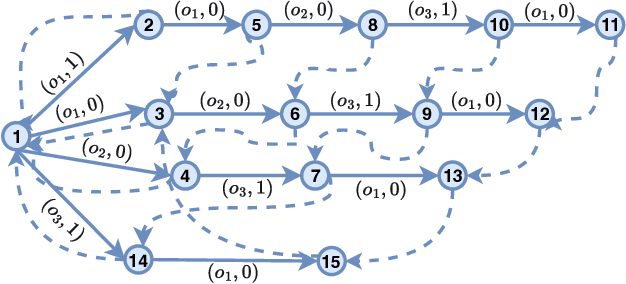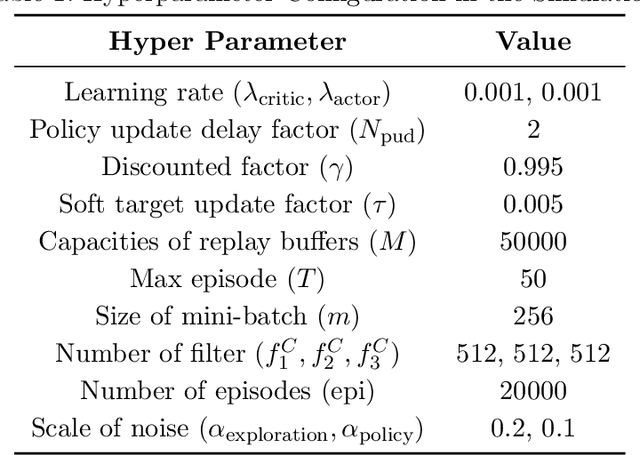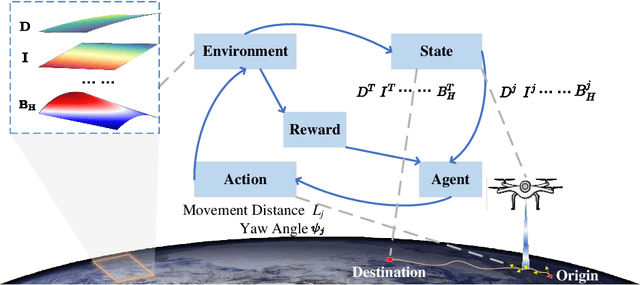Yushuai Li
Moon: A Modality Conversion-based Efficient Multivariate Time Series Anomaly Detection
Oct 02, 2025Abstract:Multivariate time series (MTS) anomaly detection identifies abnormal patterns where each timestamp contains multiple variables. Existing MTS anomaly detection methods fall into three categories: reconstruction-based, prediction-based, and classifier-based methods. However, these methods face two key challenges: (1) Unsupervised learning methods, such as reconstruction-based and prediction-based methods, rely on error thresholds, which can lead to inaccuracies; (2) Semi-supervised methods mainly model normal data and often underuse anomaly labels, limiting detection of subtle anomalies;(3) Supervised learning methods, such as classifier-based approaches, often fail to capture local relationships, incur high computational costs, and are constrained by the scarcity of labeled data. To address these limitations, we propose Moon, a supervised modality conversion-based multivariate time series anomaly detection framework. Moon enhances the efficiency and accuracy of anomaly detection while providing detailed anomaly analysis reports. First, Moon introduces a novel multivariate Markov Transition Field (MV-MTF) technique to convert numeric time series data into image representations, capturing relationships across variables and timestamps. Since numeric data retains unique patterns that cannot be fully captured by image conversion alone, Moon employs a Multimodal-CNN to integrate numeric and image data through a feature fusion model with parameter sharing, enhancing training efficiency. Finally, a SHAP-based anomaly explainer identifies key variables contributing to anomalies, improving interpretability. Extensive experiments on six real-world MTS datasets demonstrate that Moon outperforms six state-of-the-art methods by up to 93% in efficiency, 4% in accuracy and, 10.8% in interpretation performance.
Advancing Knowledge Tracing by Exploring Follow-up Performance Trends
Aug 11, 2025



Abstract:Intelligent Tutoring Systems (ITS), such as Massive Open Online Courses, offer new opportunities for human learning. At the core of such systems, knowledge tracing (KT) predicts students' future performance by analyzing their historical learning activities, enabling an accurate evaluation of students' knowledge states over time. We show that existing KT methods often encounter correlation conflicts when analyzing the relationships between historical learning sequences and future performance. To address such conflicts, we propose to extract so-called Follow-up Performance Trends (FPTs) from historical ITS data and to incorporate them into KT. We propose a method called Forward-Looking Knowledge Tracing (FINER) that combines historical learning sequences with FPTs to enhance student performance prediction accuracy. FINER constructs learning patterns that facilitate the retrieval of FPTs from historical ITS data in linear time; FINER includes a novel similarity-aware attention mechanism that aggregates FPTs based on both frequency and contextual similarity; and FINER offers means of combining FPTs and historical learning sequences to enable more accurate prediction of student future performance. Experiments on six real-world datasets show that FINER can outperform ten state-of-the-art KT methods, increasing accuracy by 8.74% to 84.85%.
MH-GIN: Multi-scale Heterogeneous Graph-based Imputation Network for AIS Data (Extended Version)
Jul 27, 2025Abstract:Location-tracking data from the Automatic Identification System, much of which is publicly available, plays a key role in a range of maritime safety and monitoring applications. However, the data suffers from missing values that hamper downstream applications. Imputing the missing values is challenging because the values of different heterogeneous attributes are updated at diverse rates, resulting in the occurrence of multi-scale dependencies among attributes. Existing imputation methods that assume similar update rates across attributes are unable to capture and exploit such dependencies, limiting their imputation accuracy. We propose MH-GIN, a Multi-scale Heterogeneous Graph-based Imputation Network that aims improve imputation accuracy by capturing multi-scale dependencies. Specifically, MH-GIN first extracts multi-scale temporal features for each attribute while preserving their intrinsic heterogeneous characteristics. Then, it constructs a multi-scale heterogeneous graph to explicitly model dependencies between heterogeneous attributes to enable more accurate imputation of missing values through graph propagation. Experimental results on two real-world datasets find that MH-GIN is capable of an average 57% reduction in imputation errors compared to state-of-the-art methods, while maintaining computational efficiency. The source code and implementation details of MH-GIN are publicly available https://github.com/hyLiu1994/MH-GIN.
Exploring the Generalizability of Geomagnetic Navigation: A Deep Reinforcement Learning approach with Policy Distillation
Feb 07, 2025



Abstract:The advancement in autonomous vehicles has empowered navigation and exploration in unknown environments. Geomagnetic navigation for autonomous vehicles has drawn increasing attention with its independence from GPS or inertial navigation devices. While geomagnetic navigation approaches have been extensively investigated, the generalizability of learned geomagnetic navigation strategies remains unexplored. The performance of a learned strategy can degrade outside of its source domain where the strategy is learned, due to a lack of knowledge about the geomagnetic characteristics in newly entered areas. This paper explores the generalization of learned geomagnetic navigation strategies via deep reinforcement learning (DRL). Particularly, we employ DRL agents to learn multiple teacher models from distributed domains that represent dispersed navigation strategies, and amalgamate the teacher models for generalizability across navigation areas. We design a reward shaping mechanism in training teacher models where we integrate both potential-based and intrinsic-motivated rewards. The designed reward shaping can enhance the exploration efficiency of the DRL agent and improve the representation of the teacher models. Upon the gained teacher models, we employ multi-teacher policy distillation to merge the policies learned by individual teachers, leading to a navigation strategy with generalizability across navigation domains. We conduct numerical simulations, and the results demonstrate an effective transfer of the learned DRL model from a source domain to new navigation areas. Compared to existing evolutionary-based geomagnetic navigation methods, our approach provides superior performance in terms of navigation length, duration, heading deviation, and success rate in cross-domain navigation.
Digital Twin-Empowered Voltage Control for Power Systems
Dec 09, 2024


Abstract:Emerging digital twin technology has the potential to revolutionize voltage control in power systems. However, the state-of-the-art digital twin method suffers from low computational and sampling efficiency, which hinders its applications. To address this issue, we propose a Gumbel-Consistency Digital Twin (GC-DT) method that enhances voltage control with improved computational and sampling efficiency. First, the proposed method incorporates a Gumbel-based strategy improvement that leverages the Gumbel-top trick to enhance non-repetitive sampling actions and reduce the reliance on Monte Carlo Tree Search simulations, thereby improving computational efficiency. Second, a consistency loss function aligns predicted hidden states with actual hidden states in the latent space, which increases both prediction accuracy and sampling efficiency. Experiments on IEEE 123-bus, 34-bus, and 13-bus systems demonstrate that the proposed GC-DT outperforms the state-of-the-art DT method in both computational and sampling efficiency.
Long-distance Geomagnetic Navigation in GNSS-denied Environments with Deep Reinforcement Learning
Oct 21, 2024



Abstract:Geomagnetic navigation has drawn increasing attention with its capacity in navigating through complex environments and its independence from external navigation services like global navigation satellite systems (GNSS). Existing studies on geomagnetic navigation, i.e., matching navigation and bionic navigation, rely on pre-stored map or extensive searches, leading to limited applicability or reduced navigation efficiency in unexplored areas. To address the issues with geomagnetic navigation in areas where GNSS is unavailable, this paper develops a deep reinforcement learning (DRL)-based mechanism, especially for long-distance geomagnetic navigation. The designed mechanism trains an agent to learn and gain the magnetoreception capacity for geomagnetic navigation, rather than using any pre-stored map or extensive and expensive searching approaches. Particularly, we integrate the geomagnetic gradient-based parallel approach into geomagnetic navigation. This integration mitigates the over-exploration of the learning agent by adjusting the geomagnetic gradient, such that the obtained gradient is aligned towards the destination. We explore the effectiveness of the proposed approach via detailed numerical simulations, where we implement twin delayed deep deterministic policy gradient (TD3) in realizing the proposed approach. The results demonstrate that our approach outperforms existing metaheuristic and bionic navigation methods in long-distance missions under diverse navigation conditions.
UniTE: A Survey and Unified Pipeline for Pre-training ST Trajectory Embeddings
Jul 17, 2024



Abstract:Spatio-temporal (ST) trajectories are sequences of timestamped locations, which enable a variety of analyses that in turn enable important real-world applications. It is common to map trajectories to vectors, called embeddings, before subsequent analyses. Thus, the qualities of embeddings are very important. Methods for pre-training embeddings, which leverage unlabeled trajectories for training universal embeddings, have shown promising applicability across different tasks, thus attracting considerable interest. However, research progress on this topic faces two key challenges: a lack of a comprehensive overview of existing methods, resulting in several related methods not being well-recognized, and the absence of a unified pipeline, complicating the development new methods and the analysis of methods. To overcome these obstacles and advance the field of pre-training of trajectory embeddings, we present UniTE, a survey and a unified pipeline for this domain. In doing so, we present a comprehensive list of existing methods for pre-training trajectory embeddings, which includes methods that either explicitly or implicitly employ pre-training techniques. Further, we present a unified and modular pipeline with publicly available underlying code, simplifying the process of constructing and evaluating methods for pre-training trajectory embeddings. Additionally, we contribute a selection of experimental results using the proposed pipeline on real-world datasets.
 Add to Chrome
Add to Chrome Add to Firefox
Add to Firefox Add to Edge
Add to Edge